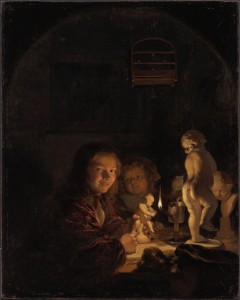
In looking at Caspar Netscher’s The Young Artists, one cannot escape its mysterious appeal. Or is it just the older boy with his unavoidable gaze and smile? The two artists sit in an arched, humble and very dark interior. Objects are cluttered among them, including plaster casts, various drawing materials, and an oil lamp. The flame of the oil lamp, which was preferred by artists of the time for its consistent source of lighting, illuminates the scene dramatically. Netscher specialized in works of everyday “genre” scenes like The Young Artists, and often included symbolic and emblematic elements as was traditional for the Dutch.
According to artistic training, apprenticeships often began later in childhood, and drawing from plaster casts of antiquity figures came before being allowed to draw from life. The older boy, now identifiable as the apprentice, pauses from his work still clutching a cast in his hand. This cast is identiied as a piece by the Flemish artist Quesnoy while the full-length figure to the right is a personification of Winter. The younger companion, and possible sibling, holds out their own “masterpiece” eager for attention. The lavish Japanese kimono that the apprentice wears, and the map nearly lost in the shadows on the wall, signify their upper class and are emblematic for Dutch trade. During this time of the Golden Age the Republic was the most prosperous nation in Europe. The increase of wealth in the middle class reflected in their dress, households, and ultimately the value of education and transmission of culture.
Annotated Bibliography: http://smalltreasures.as.ua.edu/annotated-bibliography-netscher/
Sara Caroline Taricco